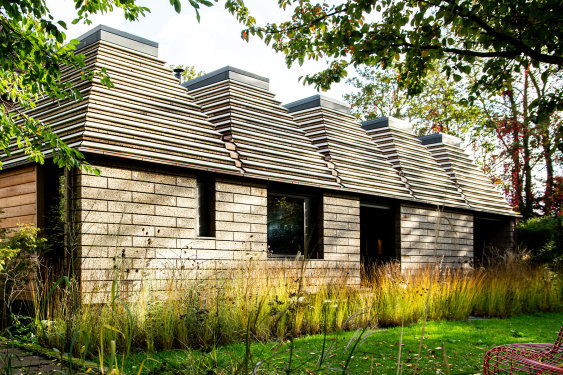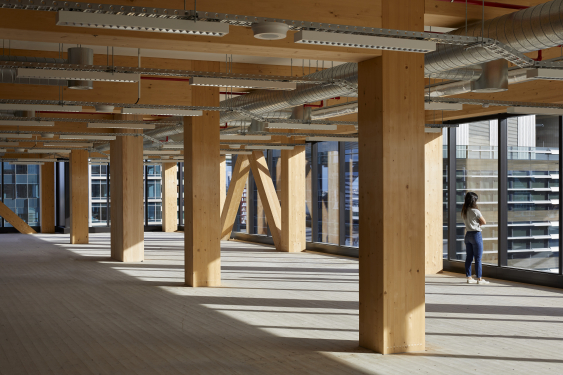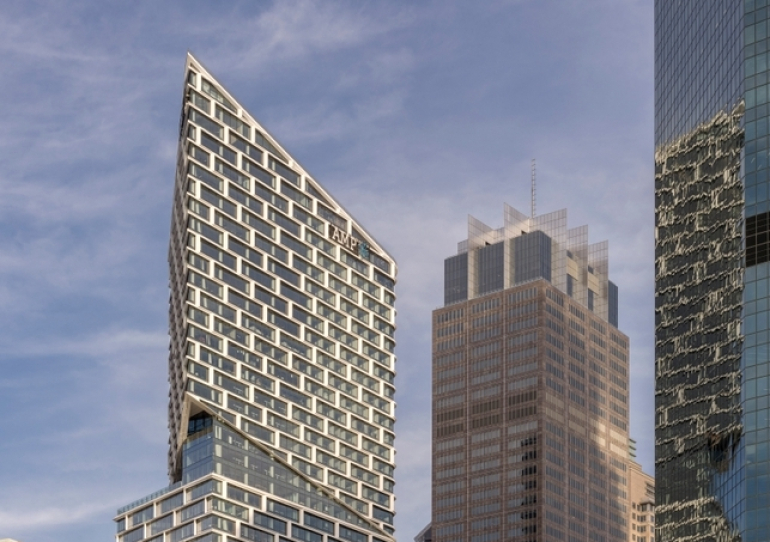In October this year the new Sustainable Buildings State Environmental Planning Policy will require architects and developers in NSW to start measuring the embodied carbon in their designs as Australia seeks to transition to a low-carbon built environment.
Associate Professor Philip Oldfield, head of UNSW’s School of Built Environment in the Faculty of Arts, Design & Architecture, explains the dilemma faced by professionals working in the built environment.
“Every square metre we build has a carbon footprint, and that can be quite high, because the materials we rely on to construct buildings are very carbon intensive. But we can’t simply stop building. We have a social obligation to provide healthy, comfortable, safe and sustainable places for people to live, to work and to play, around the world," says A/Prof. Oldfield.
“So, a key question for people working in the built environment is how can we build while ensuring new construction has the smallest possible impact on the environment?”
What is embodied carbon?
Embodied carbon is the greenhouse gas emissions associated with creating a building, maintaining it over its life, and eventually demolishing the building. “In a nutshell, it’s the greenhouse gas emissions associated with extracting and creating materials, and construction and deconstruction. And that’s different to ‘operational carbon’ which is the emissions released through the operation of the building, air conditioning, heating, cooling, lighting, plugging in your computer.”
The Australian construction industry is responsible for 18.1 per cent of our national carbon footprint, or more than 90 million tonnes of greenhouse gas emissions every year. Twenty years ago, the thinking around the carbon footprint of buildings was that operating CO2 was about 80 per cent of the building’s emissions, while embodied CO2 was maybe 20 per cent. So the focus when reducing a building’s greenhouse gas emissions was all about making it more energy efficient, and embodied emissions were generally ignored.
"The greenest building is the one that already exists."
“We have relatively mature building regulations focused on reducing operating emissions,” explains A/Prof. Oldfield. “But there are very few regulations concerning embodied emissions anywhere in the world. But the thinking about the relative importance of embodied emissions has changed as we’ve got more energy efficient, and become better at measuring embodied carbon. So, for any new building constructed in Australia today, we expect at least half of its total carbon footprint over its life will be embodied carbon, possibly even more.”
The World Green Buildings Council (WGBC) has set a target for all new buildings to be net zero operationally by 2030. What this means is the carbon footprint of our buildings will effectively be all about embodied carbon. This necessitates a big shift in the thinking about how we create sustainable buildings.
This challenge is made more difficult in the context of a growing world population and increasing urbanisation. Due to this, we are currently constructing the equivalent to every building in Japan every year. That is a lot of concrete, a lot of steel and a lot of embodied carbon. The challenge is how can we build to meet the needs of a growing society, while also reducing these environmental impacts.
Read more: Net zero for Australia's built environment is possible by 2040
The WGBC has set two targets around embodied carbon. The aim is for all new buildings, infrastructure and renovations to have at least 40 percent less embodied carbon by 2030 and to reach ‘net zero embodied carbon’ by 2050.
Four ways to reduce embodied carbon in the built environment
Rather than knock down the AMP Tower, architects 3XN innovatively stripped the building back and increased its envelope saving tons of greenhouse gas emissions in the process.
1. Adaptive reuse
A key way to reduce embodied carbon is to build less by maximising the use of existing assets. In the words of the former president of the American Institute of Architects, Carl Elefante, “The greenest building is the one that already exists.”
Architecture needs to shift from automatically building new buildings to thinking more about reuse and redesign. “Keeping the structure and becoming increasingly creative about building around it, is a design strategy with big CO2 savings,” says A/Prof. Oldfield.
A good example is seen in preparations for Paris 2024 and Los Angeles 2028, with a shift from planning new buildings to host the Olympic Games to using existing venues, retrofitting and creating temporary buildings. In fact, LA’s mantra is Radical Reuse and the city will host the 2028 games without building a single new permanent venue.
Brence Culp, LA2028’s Chief Impact Officer, says, “We were fond of saying during the bid phase, and it remains true, that the most sustainable venue is the one you don’t have to build. To tear down a venue and build a new one, purely from an environmental standpoint, represents an enormous carbon footprint. For us, working with existing venues is the best way to go.”
An example closer to home is the upcycling of Quay Quarter Tower in Sydney by Danish architecture firm 3VN. “I think this is one of the most important buildings of the 21st century,” says A/Prof. Oldfield. “The radical upcycling of a 1970s office block to almost double the floor area while saving around 7,500 tons of CO2 as well.” The building retained more than two-thirds of its original structure, including beams and columns, as well as 95 per cent of the building’s original core.

"Medium density housing and apartments tend to be smaller, more compact and often share amenity and infrastructure, all of which reduces embodied carbon," says A/Prof. Oldfield. Photo: Getty Images.
2. Build smaller
It is stating the obvious to say that smaller homes require fewer materials in their construction, giving them lower embodied carbon.
“Australian homes are among the biggest in the world and they’ve grown dramatically over the past 30 to 40 years,” says A/Prof. Oldfield.
In 2020, according to a CommSec Home Size Trends Report, the average Australian house of 235.8 square metres made it the world’s largest, larger even than houses in the US.
The kind of home makes a difference too. “Building a lot of single detached houses on the fringes of our city is not great for embodied carbon either,” says A/Prof. Oldfield. “Medium density housing and apartments tend to be smaller, more compact and often share amenity and infrastructure, all of which reduces embodied carbon.”

Cork House in Berkshire, England, is made almost entirely from solid load bearing oak, a renewable material sustainably harvested from the bark of the cork oak tree. Photo: Magnus Dennis.
3. Use low carbon materials
Replacing carbon intensive materials such as steel and concrete with lower carbon equivalents is important for reducing embodied carbon. Making use of biomaterials like timber, bamboo, straw, cork and even hemp (which can be used to make hempcrete) leads to lower overall embodied carbon, as they use less energy to create, and store carbon absorbed during their growth.
“Timber is a great material to use to reduce embodied carbon,” says Oldfield. “It’s like the anti-concrete. Cement is responsible for 8 per cent of global CO2 emissions. To put that in perspective the aviation industry is around 2.5 per cent – and just think about how much bad press air travel gets!
“When you make cement, you heat limestone, causing it to chemically release CO2. It’s the opposite with a tree. As it grows, it absorbs CO2 through photosynthesis and locks the carbon into the woody biomass. If we build sustainably from timber, buildings can effectively become a long-term carbon sink.
"Our research has shown that if we can increase our use of timber up to 30 per cent of all new multi-storey buildings by 2050, this will play a key role in getting the built environment down to net zero emissions
“We can also build out of earth, out of stone, there are a huge variety of ways to build rather than creating concrete, steel and glass monoliths.
“This is not to say we must get rid of concrete and steel, rather that we’ve got to use materials far more carefully – and treat these high carbon materials as a precious commodity. An optimal building might have timber floors, concrete foundations and stone columns, with steel connections. We need to use materials far more intelligently, optimising their use.”

Using fewer materials through pared-back design reduces embodied carbon. “Think less is more in everything from the structure of a building to finishes and fixtures,” says A/Prof. Oldfield. Photo: Tom Roe.
4. Dematerialise
The structural steel used in 19th century buildings was delicate and thin in comparison to a lot of structures today. At that time, materials were expensive but labour was cheap so it made economic sense to design in this way.
A reduction of steel or concrete in a building leads to a reduction in embodied carbon. Innovations such as 3D concrete printing are already being used to minimise the amount of concrete in some buildings. A recent innovation has been the redesign of concrete beams. A UK company Minimass has created hybrid beams with a 78 per cent reduction in concrete in comparison to a conventional beam.
“Think less is more in everything from the structure of a building to finishes and fixtures,” says A/Prof. Oldfield. “So for example, instead of suspended ceilings, no ceiling and exposed beams. Instead of carpets which need to be replaced every 10 years have polished floors. It’s about questioning whether you need every material in the first place.”
